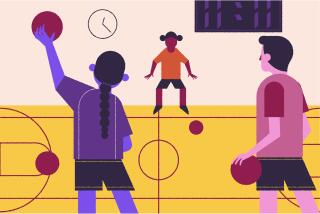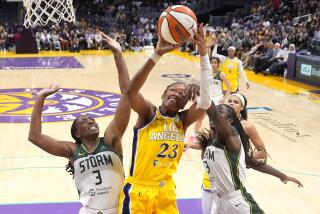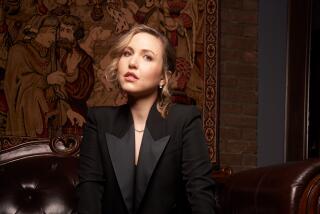They See the Light at Midnight
- Share via
At first they came one by one, then in small groups, recently in droves. There is now a waiting list for the Midnight Basketball League in Glenarden, Md. From 10 p.m. to 2 a.m. several nights a week, the Glenarden Community Center gymnasium is the place to be if a young man wants to get off the streets and on with a productive life.
President Bush came to testify to that fact Friday, citing Midnight Basketball as the 124th “Daily Point of Light” in his 1,000 points of light program. The president faked a reverse dunk with a basketball autographed by the members of two local “all-star” teams. He talked about dazzling nighttime shooting, courageous airborne maneuvers and spectacular tactical wizardry. Like the people who run the Midnight Basketball League, the president used the imagery of basketball to grab attention before making his real point. “I came here to see this Midnight Basketball myself,” he said. “Here, everybody wins. ... Everyone gets a better shot at life.”
The president said over and over again how glad he was to be in the gym, and you got the impression he still was understating his feelings because few programs designed to get young men off drugs and street corners have worked as well and as quickly as the Midnight Basketball League. “The last thing Midnight Basketball is about is basketball,” he said. “It’s about providing opportunity for young adults to escape drugs and the streets and get on with their lives. ... It’s not coincidental that the crime rate is down 60 percent since this program began.”
There’s not a lot of fancy stuff here. G. Van Standifer, the former Glenarden town manager, figured late-night basketball could provide an alternative to whatever else teen-agers and young adults were getting into -- mostly bad -- in his community. There are now 52 cities that have entered into a licensing agreement with Midnight Basketball. In Chicago, there are more than 100 teams. Atlanta, Miami, Boston and Hartford are planning to begin the program this summer. Washington will add another in June.
Fred Brown, the former Georgetown star and innovative entrepreneur, and Tony Towns, a lawyer for the Office of National Drug Control Policy, have obtained a license for Midnight Basketball as part of their Process HOPE (Help Overcome Poverty Through Education). Charlene Drew Jarvis, a District of Columbia Council member, has taken an active role to bring a league to her neighborhood and already has asked the businesses in her Takoma Park, Md., community to open their cash registers.
Here’s how Midnight Basketball works: Somebody from MBL, let’s say Brown, walks up to a high-school dropout on a basketball court. Brown sells the kid on great basketball played before lots of people. What he doesn’t mention is that between these games there will be academic seminars, vocational workshops, family counseling. If you don’t want to go to the seminars you’re out. And who wants to be back on the streets when all his buddies are in the gym?
What Midnight Basketball has succeeded in doing is making peer pressure work for it. Vincent Smith, 21, was one of the players who received words of thanks and encouragement from the president Friday. “He said he was glad we were volunteering to be in something where we learn responsibility,” Smith said, “where we learn how to be leaders, that he needs more of this. I pulled my man over here, Russell Young, into Midnight Basketball.” Smith has gone back to school, to Prince George’s (Md.) Community College, and he keeps telling everyone within earshot to do the same.
Anthony Beard is planning to attend PGCC this fall. “There are seminars during Midnight Basketball on financial aid, on taking your board exams and getting counselors,” he said. Beard and Joseph Lee play at Hine Recreation Center at Eighth and Pennsylvania Avenue SE in Washington. The league there has been going for two or three months.
“They lure you with ball,” Lee said. “Everybody thinks he can play ball. Then they hit you with family counseling or something. There’re a lot of guys out there on the fence, maybe already in trouble. They need someone to push them in the right direction. We’ve pulled in people like that, though I’m not going to name names. Guys have come in and cut out street things. Am I surprised it’s working? No, not really. I think we’re all surprised it’s worked so fast.”
It’s working so far because no bait is as effective as basketball. And no place, without exception, is as basketball-crazy as the urban communities in the Washington metropolitan area. “Our program is a sham on one level,” said Towns, the attorney. “Basketball is just the carrot that we’re dangling. We don’t tell them about the workshops and seminars, we only tell them about the basketball. Once they get in, we go to work on them.”
Some of them have been hard-core street kids, which is why one of the workshops is conducted by the Washington Violence Prevention Program, a group of health-care professionals from a local shock-trauma unit who felt the helplessness of seeing men like these (17 to 25 years old) killed and maimed. Brown is already looking toward a program similar to Midnight Basketball for kids, age 10-17, “aimed at prevention, not correction,” he said.
Brown and Towns have started working on some of the seminars, including a pre-PSAT program designed to make kids realize that there’s no law preventing high scores on the court and the college boards too.
Bush’s appearance here is sure to result in a short-term boost for the program, one that George Washington student Chris Johnson, 23, said “should be implemented throughout the country. Does it take that much to open a gym and get some counselors and hold seminars? The strongest vehicle we have in urban America is basketball. ... If it can draw some people in until their eyes are open, that’s pretty good.”
More to Read
Go beyond the scoreboard
Get the latest on L.A.'s teams in the daily Sports Report newsletter.
You may occasionally receive promotional content from the Los Angeles Times.










